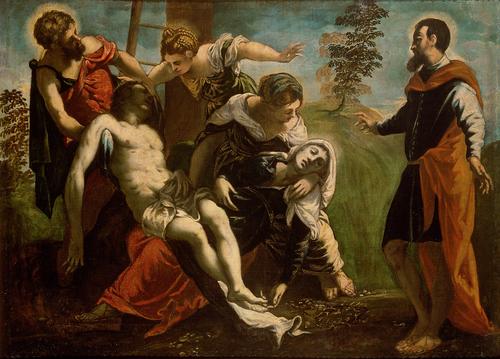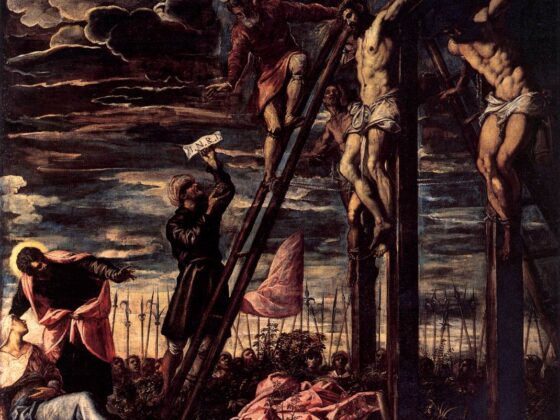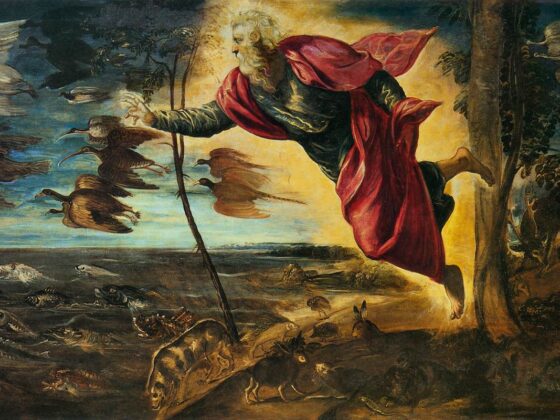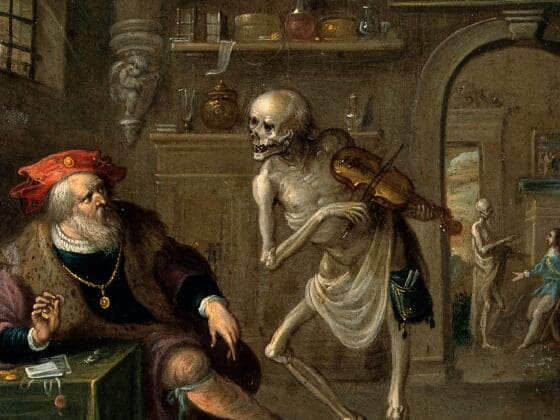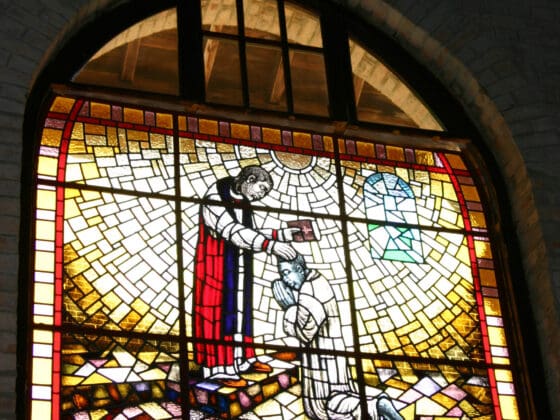“Woman, behold, your son!” … “Behold, your mother!”
John 19:25-27
I preached this meditation on Good Friday 1999 in my parish church in Sewickley, PA, shortly before my wife and I made a momentous trip to Africa. For a more recent meditation on this word, see my post “I’m Trading My Shame.”
“Woman, behold, your son!” … “Behold, your mother!” The third word from the Cross is surely the most mundane of the seven. Jesus cried out to his Father; Jesus spoke words of eternal comfort to the penitent thief. But here, it seems, he simply completes a piece of family business. One might even wonder why, knowing that he was going to die, he had not made the arrangements for his mother earlier.
But is this really all this word is about? The church fathers had a way of reading Scripture that allowed for several levels of meaning in a text, in some cases finding four separate senses. We might call these levels the plain sense, the moral sense, the spiritual sense, and the final sense. Let’s look briefly at Jesus’ words to his mother and the beloved disciple John from each of these perspectives.
The Plain Sense
At the literal level, our text attests that there were real witnesses to Jesus’ death and his final words, a company of faithful women and one man. An execution, then or now, is a gruesome and publicly shameful event, but these women did not hesitate to go to the foot of the cross. And in their midst was Jesus’ own mother. She of course had conceived this child in wonder and out of obedience, and with a hint of public scandal. She had been warned that one day “a sword would pierce her heart.” Now the prophecy came true, in a mother’s grief we can hardly attempt to imagine.
And let’s also consider the witness of the apostle John here. For John to be present at the Cross was positively dangerous. Jesus was executed as an enemy of Caesar and a Jewish pretender, the “King of the Jews.” “Were you not with the Nazarene, Jesus?” was the very question that caused Peter, in the fire-light, to deny the Lord. But here, in broad daylight, John bears witness to his relationship to Jesus. Indeed, Jesus “adopts” him, as it were, as a brother by giving his mother to him to care for as a son.
Why was Mary not cared for by the brothers of Jesus, James and Jude? We do not know. It seems consistent with the radical nature of Jesus’ fellowship that the Virgin Mary was entrusted not to next-of-kin but to his closest disciple, John, and tradition says that Mary lodged with the apostle even when he moved on to Asia Minor in later years. When Jesus had said “Who are my brothers and mother?” he meant it. From this hour on, Mary and John became as mother and son.
The Moral Sense
There were no doubt many biographical details that John could have included in his Gospel and did not. Why did he put this little vignette right in the middle of the Crucifixion story? What is the importance of taking care of his mother compared to the mighty work of salvation that Jesus was finishing?
Perhaps this is the moral point that John wishes to make. From the agony of the Cross, Jesus focused his mind on one detail of everyday existence, the care of his mother. The Gospel is quite clear that everyday life can be a road-block to Christian faith. The cares of this world like weeds can choke the word of God. Family ties especially can prevent someone from following Jesus. Matters of inheritance are especially sticky.
But to those who may get heady or romantic about having “sold out” for Jesus, he says, “Behold thy mother.” There is among some Christians the tendency of the Peanuts character Linus to say “I love mankind; it’s people I can’t stand.” We find it difficult to bring the love of God into the everyday affairs of life.
When I moved to Sewickley almost 19 years ago, Peggy and I were a young couple with four healthy children and four doting grandparents. Over those years, all of our parents aged markedly and all but one have died. The stresses of trying to be a good son or daughter and a good father and mother have tested us and shown us many times how little competent we were in either role. The burden of these years has left an indelible mark in our souls.
When Jesus said to John, “Behold your mother,” he bequeathed to him all the difficulties of family living, of providing care, and of watching as the ravages of sin, sickness, and death took their toll on that woman. On the other hand, maybe Jesus knew what John needed to fulfill his calling as apostle. John’s Gospel is known for its spiritual, almost otherworldly character, which is then mixed with vivid concrete details like this word from the Cross. Is it too much to think that Mary, with her motherly concern for the personal life of Jesus kept the Beloved disciple rooted in history and reality when he would have been tempted to live in realms of eternal light?
The Spiritual Sense
Having honored our Lord’s care for his mother, I must also note that he did not, in fact, call her “Mother,” but rather “Woman.” As a matter of fact, never in any of the Gospels does Jesus ever speak to her as “Mother.” Even when he was a boy and an anxious Mary said to him, “Son, why have you treated us so? Behold, your father and I have been looking for you anxiously,” Jesus said in return (never acknowledging their parental role), “How is it that you sought me? Did you not know that I must be in my Father’s house?”
It’s not just a matter of names either. There is not a truly positive exchange between Jesus and Mary in any other Gospels, anywhere, until this moment from the Cross. To be honest, this was the first kind thing Jesus said to his mother. Why is this? Surely, Freudian explanations are worthless. The truth is, Jesus was not belittling his mother in any way. Just the opposite. By calling her “Woman,” our Lord seems to have designated her as an eternal representative or type of his Kingdom.
As “woman,” she is the New Eve. The first Eve was to have been the “mother of all living,” and in a sense she did pass her sin-damaged inheritance down to us. But the “Woman” whom Jesus names from the Cross is to be the forerunner of a new humanity, who are born not of the flesh but of the Spirit. She represents the catholicity of the Church, the fact that all Christians have the same spiritual source in Christ. And if she represents the church’s catholic nature, then John the beloved disciple, is a sign of its apostolicity. It is John who leaned on Jesus’ breast and heard his most intimate words and understood that He is the Way, the Truth and the Life. It is John, the apostle of apostles, who taught most fully that believing the truth is a matter of faith and love and courageous witness even unto death.
The spiritual sense of this word, then, is that Jesus is founding his future community on two human types, his Mother and his Disciple. When the catholicity of the church, the love of Christ’s people, is joined to the truth of the apostolic word, then, and only then will Jesus’ prayer be fulfilled that “that they may all be one; even as thou, Father, art in me, and I in thee, that they also may be in us, so that the world may believe that thou hast sent me” (John 17:21).
The Final Sense
The final sense of Scripture has to do with the end of all things. And it just so happens that John the Divine spoke prophetically about the role of Jesus’ mother as a symbol of the Church in this weird and wonderful passage in the book of Revelation:
…a woman clothed with the sun, with the moon under her feet, and on her head a crown of twelve stars; she was with child and she cried out in her pangs of birth, in anguish for delivery. And … behold, a great red dragon, with seven heads and ten horns, and seven diadems upon his heads… And the dragon stood before the woman who was about to bear a child, that he might devour her child when she brought it forth; she brought forth a male child, one who is to rule all the nations with a rod of iron, but her child was caught up to God and to his throne, and the woman fled into the wilderness, where she has a place prepared by God, in which to be nourished for one thousand two hundred and sixty days. (Revelation 12:1-6)
This vision is an imaginative way of describing what happened on the Cross. At the turning point of all history, Jesus defeated the ancient enemy of the human race. At the most vulnerable moment of a mother’s life and a child’s, the moment of birth, Satan was ready to pounce but was left empty-handed. Not only did Jesus ascend to his Father’s throne, but his mother was also protected. It says a few verses later she was given wings to escape and the earth came to aid her by swallowing up the venom of the Evil One. God was not going to leave this woman, who symbolizes the people of God, comfortless.
Yes, the third word – “Woman, behold, your son!” … “Behold, your mother!” is indeed a mundane word. From the Cross, Jesus provided for his mother’s future needs. But in a final sense, it is a supra-mundane, a heavenly word. Jesus made sure that there would never be anything that could separate his mother – or his people – from the love that he displayed on the Cross. It was as if Jesus turns to each of us and says: “My friends, from this hour on, you will be always with me and I with you, however much your faith may be tested. Hold fast your testimony to me to the end, and I will receive you in my heavenly home, the Paradise of God.” You and I can be certain this day that if we are members of his Church, united in fellowship and truth, we will remain with him for all eternity.
***
Collect for the Tuesday of Holy Week
O Lord our God, whose blessed Son gave his back to be whipped and did not hide his face from shame and spitting: Give us grace to accept joyfully the sufferings of the present time, confident of the glory that shall be revealed; through Jesus Christ our Lord, who lives and reigns with you and the
Holy Spirit, one God, for ever and ever. Amen
Today’s Hymn is “Leaning on the Everlasting Arms” written by Anthony Showalter and Elisha Hoffman and performed by the folk singer Iris DeMent, The hymn is based on the text from Deuteronomy 33:27 “The eternal God is thy refuge, and underneath are the everlasting arms.” I’d like to think as well of the Christ-child resting in his mother’s arms, and the Beloved Disciple resting at table in his Savior’s arms.
Cover Art: Tintoretto, “The Deposition of Christ” (Wikimedia Commons). Note the Virgin Mary: “a sword will pierce through your own soul also” (Luke 2:35).
